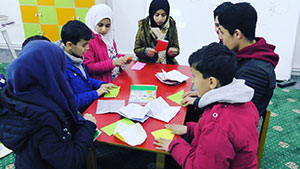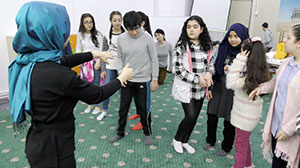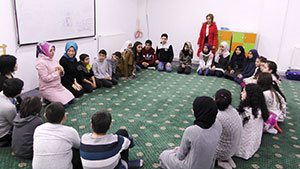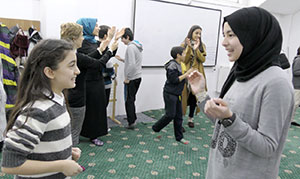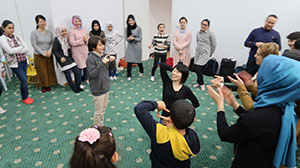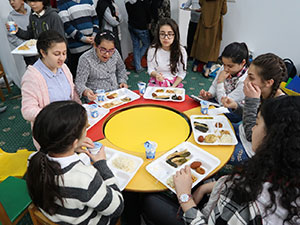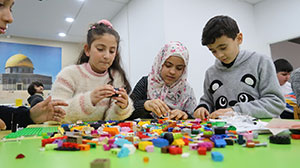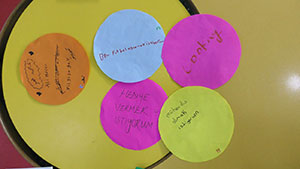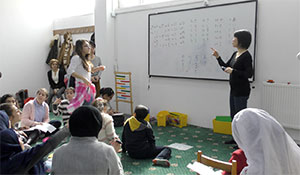30th JAMCO Online International Symposium
February 2022 - March 2022
For a Sustainable World – Responses to the COVID-19 Crisis
Design for the Generation of Shared Spaces through Play
―The Example of a Refugee-support NGO in Turkeyー
Keywords: Syrian refugees, social cohesion, divisions, Turkey, audience, spatial design
1. The Reception of Syrian Refugees in Turkey
As of October, 2021, some 5.65 million Syrian refugees had fled abroad (UNHCR 2021) since the present crisis erupted in Syria in March, 2011, making this one of the greatest refugee crises of the century so far. Syia’s neighbor, Turkey, has received over 3.7 million of these refugees, more than any other country. The Turkish government decided to receive Syrians as guests, not refugees, from shortly after the crisis began in 2011. The number of Syrian refugees continued to rise, however, and the Turkish government promulgated a new Law on Foreigners and International Protection (LFIP) in 2014. Under this law, the Directorate General of Migration Management (DGMM), which is attached to the Ministry of the Interior, introduced a Temporary Protection Identity Document (TPID) for issuance to refugees in order to keep tabs on the situation. Simultaneously, it started coordinating also with other ministries and agencies to provide social welfare services for Syrian holders of the TPID. A consequence of this was that whereas registered TPID holders were able to receive social welfare services, those not registered in this way could not, and became ever more socially isolated. The reasons for their non-registration included both insufficient distribution of information on how to register, the complicated registration procedure, the hesitation of refugees who regarded their stay in Turkey only as a stepping stone to Greece or other EU states, and anxiety that the Turkish government may release the registered data so collected to third parties. (Yamamoto, 2016)
90% of the Syrian refugees who fled to Turkey live in large cities. They dwell within the Turkish community, and make their own housing and other daily arrangements. 10% are protected in refugee camps administered by the Disaster and Emergency Management Presidency of Turkey (AFAD), which are designed to provide basic short-term needs. The government provides public assistance but the Syrian refugees in this shared situation also help each other considerably with their daily needs.
In contrast to the refugees of the camps, the urban refugees live under a wide variety of circumstances, which makes it harder both to grasp their situation from the outside and to provide them with assistance. The Turkish government provides basic social services free of charge to TPID holders, including education, healthcare at public medical institutions, and welfare, (Sato and Takayama, 2018), but there is concern that the necessary information is not reaching those who are not well integrated in Turkish society.
2. The Divisions in Urban Areas
The divisions that separate the living spaces of Turkish and Syrian residents breed prejudice and discrimination, and sometime lead to clashes. Turkey was generous in receiving refugees from its Syrian neighbor following the outbreak of the civil war in that country. One Syrian who fled to Turkey in 2012 shortly after the crisis began spoke in these terms about the Turks in an interview: “Six years ago, when I arrived in Turkey, they lent me an apartment free of charge, because they thought I needed shelter, and brought me pots, dishes, blankets and other things because they worried about my daily needs.” Another said, “Turkey and Syria used to be a single country, so everyone looked after us as if we were one people.” A Turkish respondent remembered, “We were sorry for them at first, so we opened our houses to them and gave them everything they needed.” Almost inevitably, however, such comments are now qualified by a “but”. “We welcomed them at first, but…”, or “We did everything we could for them at first, but…” The longer the Syrian crisis continued, and the larger the number of refugees became, the bigger also was the impact on the host communities. There were heavier loads on public services, including the water and sewage systems, garbage collection, public health and medical facilities, schools, and welfare provision. In daily living spaces, too, differences emerged in the use of public facilities, such as parks and toilets, and also in work customs. The cultural frictions gave rise to increasing dissatisfaction and the growth of anti-Syrian sentiment. These negative feelings lead easily in turn to an upsurge in prejudice and discrimination, and to clashes and divisions.
3. Social Cohesion Initiatives in Turkey
The unprecedented influx of refugees itself constitutes a humanitarian crisis that threatens people’s personal safety. Simultaneously, it also poses difficult challenges for the receiving country in terms of balancing the protection of the foreign refugees’ human rights with the interests of its own population. The case of Turkey is no exception, and the admission of over 3.7 million refugees has produced economic, political and social tensions. According to one survey (Murat, 2014), a majority of Turkish citizens regards the Syrian refugees as a burden or risk, and an overwhelming majority opposes the granting to them of full citizenship rights. In this situation, the maintenance of social cohesion has become a core priority.
The International Organization for Migration describes social cohesion in a paper on immigration in terms constructing communities that foster mutual trust between citizens (IOM, 2017). The Council of Europe, which performs a leading role in setting the global norms for human rights, democracy and the rule of law, describes social cohesion as ‘an essential condition for social justice, democratic security and sustainable development.’ It continues, ‘Divided and unequal societies are not only unjust, they also cannot guarantee stability in the long term.’ These shows that the socially cohesive community consists of members who, drawn from different cultural or religious backgrounds, share dissimilar values but nonetheless cooperate unstintingly from a common standpoint to achieve common goals.
The Turkish word ‘uyum’ is typically used to translate ‘social cohesion’. The coinage is still recent, however, and its meaning covers a wide spectrum from assimilation and integration to harmonization and multi-culturalism. To investigate the inclusiveness of Turkish society with regard to Syrian refugees, the author and her colleagues interviewed people responsible in governmental ministries and agencies, academic researchers, NGO members etc. and assessed the degree of inclusivity in the manner shown in Figure 2. The standards employed by and within these various organizations during the author’s survey period in Turkey were not consistent. All, however, were seeking to avert conflicts between the host communities and their refugee guests, and find ways to integrate the refugees into those host communities.
Under these circumstances, both international organizations and NGO’s were implementing programs and projects aimed at enhancing social cohesion. The surveys revealed that these initiatives had in common the goals of producing connections between people who were living together, and nurturing the knowledge and skills necessary for them to live to be able to live together well. They were seeking, in short, to generate personal relationships between the Turkish and Syrian populations. On the other hand, it was also clear that many people in these shared living spaces were not endeavoring to connect or talk with each other.
This research project examined the case of NGO X, a group which provides spaces for Turkish and Syrian people to connect, develop relationships, and coexist, in order to identify elements that promoted and obstructed social cohesion.
Figure1: The Uyum Concept
(Produced by the author and other members of the survey team)
| Uyum | ||||
|---|---|---|---|---|
| Strong ―― Degree of assimilation to the Turkish community ―― Weak | A community built on mutual trust | |||
| Assimilation | Social Integration/ Inclusion/Adaptation |
Harmonization | Multi-Culturalism | Social Cohesion |
4. 1. Outline of NGO X
X is an NGO engaged in supporting refugees in Gungoren, a suburb of Istanbul. X started out as a TEC (Temporary Education Center) managed by Syrian refugees. (For details of the TEC’s, refer to Yamamoto, 2019). Schooling was provided in Arabic chiefly for child refugees who had fled Syria shortly after the crisis began in 2011. The TEC’s were phased out in 2017 and converted instead to educational facilities for promoting social cohesion by providing, for example, Turkish language lessons for adults, and vocational training for the disabled. Ms.A, the director of NGO X, is a Turkish Arab, fluent in both Turkish and Arabic, who has served as a bridge between Turkish society and the Syrian refugees. He and all of his colleague at the NGO are keenly aware of the need to build relationships between Syrians and Turks, and use donations from local organizations and individual supporters to furnish activities for enhancing social cohesion.
Ms.A explains that many women and children, especially, have been traumatized by the civil war and experience many difficulties, including separation from family and community, a new, unfamiliar lifestyle, and altered familial relationships. Often children, for example, though reasonably conversant in Turkish for most everyday purposes, struggle with the more difficult terms used in school lessons or lack the socially specific background knowledge and framework needed to follow the lessons well. They feel ill at ease in the Turkish school environment, and may refuse to go to school at all. Such children become socially isolated (as of March, 2018). Syrian families whose members feel unwelcome in Turkish society stay home more and make little effort to integrate with the community, producing thereby a vicious circle of ever-increasing social isolation.
NGO X provides social cohesion activities for children and encourages their parents and guardians to join in. The idea is that women who are tending to shut themselves up at home will come out if it is for the children. Placing the children at the center of the activity brings their mothers together, and provides a space for the mothers to converse with each other.
Issues do, however, remain. Relationships between these Turks and Syrians do not form automatically simply by bringing them together in a common space. Other NGO’s, too, have experienced this same challenge. NGO X’s answer, rather than only bringing them together, has been a trial-and-error process of arranging for them to engage in activities together. An example of this is the main subject of this paper.
4. 2. The Example Activity
The example introduced in this paper was a one-day program implemented by NGO X at the local Social Service Center (SSC) from 10:00 to 16:00 on Saturday, 3rd March, 2018, as shown in Figure 3. This was a play activity produced on the theme of improvisation. The names and procedures of the activities were chosen and designed in accordance with the Turkish context.
Three reasons were given for why this social cohesion activity was based on improvisation. First, improvisation depends on input from the players. It is a joint, creative process. Second, based as it is on physical movement, improvisation is the kind of activity that all players can participate in easily. Third, there are diverse ways to participate, including as players, the audience, followers, and followers of followers. People can participate in whatever manner they wish.
The children’s parents and guardians were also asked to help with preparation of the mid-day meal.
Figure2: Program content and scenes
4. 3. Participants26 schoolchildren between the ages of 12 and 15 participated in this program, namely 14 Turks and 12 Syrians. The Syrians were children who already came to NGO X together with families and friends. The Turks were invited through the cooperation of a local public school that understood the significance of social cohesion activities.
Most of the Syrian children had been attending Turkish public schools for about a year and understood some Turkish, but not yet enough. Some were attending a private school which provided lessons in Arabic, and could hardly speak Turkish at all. The Turkish children mostly only spoke Turkish, but some had recently started learning Arabic and knew some elementary phrases.
The program was planned and prepared by three social workers of the Gungoren SSC. These three social workers, the facilitators, were the author’s counterparts and had developed the program on the basis of the analysis of examples of social cohesion activities in Turkey and abroad. They could not speak Arabic, however, so this activity was implemented using simple Turkish phrases. Where conversation in Arabic was necessary for communication, the author interpreted from Arabic to English, and another interpreter, from English to Turkish and back.
5. Analysis of the Field Notes Focusing on changes in the Children through Play
This study used data obtained from observation records, interviews conducted with the children during the activity, the children’s comments after the activity, and interviews with NGO X staff members and the three social workers who served as facilitators, to compile field notes and analyze changes in the children, with special attention to the structures of their relationships. In the following, passages from the field notes are shown in italics and discussed:
5. 1. Not connecting or forming relationships with people in the shared space
The Syrian children gather from shortly after 9:00. They start to interact while having a go at origami paper folding and writing their names in Japanese. The Turkish children arrive shortly before 10:00. With everyone now present, the three social workers serving as facilitators explain the day’s agenda. At this point, the Syrian and Turkish children are clustered in their own respective groups and not conversing with each other.
The children spoke among themselves in their own language, Syrian and Turkish, respectively, and felt unable to address children of the other group. The children were clearly divided into their respective national groups in the hall. In order to change the spaces which they occupied, the first activity, the Line Up Game, was now commenced. The point of the Line Up Game was to form a single line according to a given theme.
The Line Up Game begins. The children select their own positions and form a single line in response to the social worker’s prompting. The children are expected to consult with the children closest to them when selecting their own positions, confirming they are in the right place, and making adjustments. In fact, they perform the task silently. The children move in their groups of friends. The facilitators tell them to split up as much as possible. Once the line is formed, the facilitators tell the children to talk with the children closest to them about why they have chosen that position. This only produces conversation between clusters of friends who have moved together. There is still no conversation between the Turkish and Syrian children. Several children are standing alone… A facilitator asks a Syrian child, “Won’t you try discussing it in Turkish?” The child answers, “I’m no good at Turkish. That person can do it, but not me.”
The Syrian and Turkish children still hardly interacted with each other at all to the end of the first activity. Four Syrian children did not participate in this activity but played separately at the back of the room.
5. 2. Interaction begins
The program next progresses to a clapping game called Ding Dang Dong, which follows the rhythms of the Turkish language. The children form a ring and take turns to clap. First, the clapping is transmitted clockwise, and then, anticlockwise, quickly and rhythmically. The children cannot do it well without watching each other’s eyes and movements closely, and so they do. Once they have more or less mastered the basic task, the clapping sequences are transmitted to random recipients. The children cooperate to make the sending and reception easier.
The children form the Ding Dang Dong ring and produce the rhythms by clapping. They first learn to send the rhythms clockwise and anticlockwise, and then pass them on randomly. They only interact with their friends at first, and only some of the children participate. Also, when uncertain who to pass the rhythm on to, children send it to a facilitator instead, who expresses shock at having to do it yet again and sends the rhythms back to as many children as possible so that everyone has a go. Children who cannot pick another child to receive the rhythm, however, then send it back to the facilitator again, or else only send it on to their friends. The circle of communication does not grow at first but the situation improves as the children start calling out to each other. When one child is uncertain who to send the rhythm to, another calls out, “Send it to me!” When a child is going to send the rhythm to a chosen person, others call out to the target, “He’s sending it to you!” A sender calls out her chosen recipient’s name. This interaction makes the game work more smoothly. Once children begin calling out to send it to them, everyone starts to become involved. Children who looked anxious at first begin to relax and start smiling as they receive the rhythm and pass it on. Calling out each other’s names and passing the rhythm on, children begin to interact with children they had not connected with before. Once they can do it rhythmically, skillfully and quickly, they all enjoy the pleasure of success. The Syrian and Turkish children smile together and naturally start to interact. The four Syrian children who had not participated from the start join in midway and enjoy the game with the other children. After Ding Dang Dong, the children have started to call each other by name.
The lesson of the second activity was that the children themselves began to redesign the play space in order to enjoy Ding Dang Dong. It was easier for everyone to participate once the children had started calling out to each other to send or receive the rhythms, and used each other’s names.
Activity 3, Praising Mistakes, was a game in which the children congratulated each other on their errors. The children worked in pairs and told each other numbers, 1, 2 or 3. In the first round, they had to tap their hand for 1 but repeat 2 or 3. In the second round, they tapped their hand for 1, stamped their foot for 2, and repeated 3. In the third round, they shook their hips for 3. Mistakes were sure to happen as the tempo rose. When that happened, the child who made the mistake announced loudly and happily to everyone, “I got that wrong!” Everyone yelled back, “Well done!” Whereas mistakes would generally be viewed in a negative light, in this case everyone celebrated the errors together, producing a relationship in which the children could accept each other’s mistakes without fear.
Several children make faces when the game is explained but the children start laughing when some of the boys have a go. The children are told to walk slowly around in the room and then pair up with the person nearest them at the signal of a clap. Whereas the children were still tending to cluster in their familiar groups until now, this time, they are all shuffled up together and the resulting combinations include many Turkish-Syrian pairs. Some children hesitate to speak out loudly at first when they make a mistake, but their partner pushes them forward, they announce their error, and everyone applauds and congratulates them roundly. Children who looked anxious at first now relax and start having fun. Some make deliberate mistakes in order to receive the applause. The children shout out loudly and express themselves with their whole body, and soon every child is able to do these things.
Activity 4, the Thank You Game, is an improvisation game. The players form a ring and one steps into the circle to strike a pose. Another player then joins in the pose to complete it. The first player to strike a pose thanks the player who completes it. That player then strikes a new pose, and another player from the circle completes it.
A Turkish boy is the first to strike a pose inside the circle. A second Turkish boy completes it. Even a pose that is hard to interpret is made meaningful when a second person adds to it. The children become fascinated by this process and participate. A few of the boys tend to monopolize the proceedings at first, but the facilitators encourage the girls to take part, too, and before long both boys and girls are playing the game. The children produce many imaginative ideas and respond to some of the ideas for completing the poses with amazement, admiration and praise. Even totally meaningless poses are made meaningful by the additions. Once the children are all taking part, irrespective of whether they are Turkish or Syrian, boys or girls, several children start stepping forward to complete the poses, though the rule was for only one person to do so. In this way, they start to build stories. In the photograph, a Turkish child has supplemented the author’s pose by making a gift of flowers. A Syrian child then poses as if taking a photograph. Everyone takes part in this game together, Turkish and Syrian. The children laugh a lot and tell each other in Turkish, and sometimes in Arabic, how interesting, good, wonderful and surprising they find the various ideas.
Activities 3 and 4 saw all children taking part regardless of their nationality or sex, and laughing and interacting together freely. The two activities had, at least, the two points in common. One was that another child always reacted to a first child’s action. Both games were made meaningful by this mutual action and reaction, and that depended on the contributions made by both children. The games only worked because of those contributions. The other was that the fun and interest were derived from the diversity. Both successes and failures became a source of friendly laughter, and the children impressed each other with some striking ideas. The others laughed at both the mistakes and the mysterious poses, and enjoyed the process by which meaning was produced through their own contributions.
The foregoing activities were completed in the morning session and the children now took lunch. The Turkish and Syrian children shared the same tables over lunch. The food was prepared by their parents and guardians, and consisted of plates of both Turkish and Syrian food. They told each other about their respective dishes while they ate. After the meal, the boys started a game of football with a cushion ball. They had connected with each other, and played.
5. 3. Relationships are Broken
The afternoon session started with serious play using Lego blocks. The children were divided into mixed groups of both Turkish and Syrian children. A child capable of interpreting between Turkish and Arabic was placed in each of these groups. Lego blocks were provided on each table and the children used the bricks to express their own ideas in response to prompts from the facilitators.
Almost all of the children are intently focused on making things with Lego from the start of the activity. They work in silence. The prompts include, “What are your strong points?”, “What do you like best?”, and “What kind of town would you like to live in in the future?” They are expected to use the Lego to answer these questions and talk about their intentions with each other, but the children say nothing. The children bring the models they have made on their own to show to the facilitators… They are told to return to their group and tell their friends about them. They want to do so, but their friends are still engrossed in making their own Lego models. For others, language problems stand in the way. They stop trying. … The author saw one Syrian child being alone and asked her in Arabic about her strong points. The child answers, “nothing”. The author says anything is OK. The child answers, “I don’t know” and, without looking up, carries on playing with the Lego. Before long, the conversations stop in every group. Without conversation, the activity cannot continue.
Activity 6 broke the connections. At least two points can be made here. One regards language. Unlike activities 2-5, Activity 6 entailed an important language element. Not only were the Syrian children unable to express themselves well but their companions were also engrossed in their own Lego modelling and did not pay attention to what they were trying to say. We may say the children ended up by withdrawing from their relationships. The Turkish children, too, could not be sure when they explained their models in Turkish that they were really being understood. They ended up just telling other Turkish children or the facilitators about their works.
Past experience of group work was also a factor. NGO X staff members explained the Syrian children had almost no previous experience of group activities and, therefore, no familiarity with presenting their thoughts to others or asking others for theirs.
Activity 7 was the Exchange Game. The children wrote what they wanted and what they could give on the two sides of a paper coin. The idea was to match the things that children wanted with those that other children were prepared to give. As in Activity 6, language had a central role to perform in this game, and the conversations failed to develop. Further, some of the Syrian children were unable even to write something they wanted or could give. As in Activity 6, it is believed they were unaccustomed to the rules and procedures of group activity.
Activity 7 was expected to be the day’s last game but the connections produced in the morning session had disappeared in the course of Activities 6 and 7, so an eighth activity was added at the finish. This additional Activity 8 consisted of having the children write their names in Japanese(phonetic script). Since Japanese was a completely new language for all of them, they did help each other to write their names in this unfamiliar script. Finally, the children were asked to write down their impressions of the day’s activities on a slip of paper, and the children dispersed. Their comments describing their personal experiences and interactions are listed in Figure 4. These comments indicate that the program did help to nurture social cohesion.
Figure3:The children’s comments written on slips of paper
| Experiences | Interactions |
|---|---|
|
|
This study examined the activities of NGO X with the purpose of identifying factors that promote or obstruct the growth of social cohesion. The findings suggest that two aspects that need to be included in the design for play to nurture social cohesion, as follows:
- (1) Performance as an audience is key for generating social cohesion
The students were developing emotionally as they collaborated with others in building functional relationships through play. Developmental psychologist Lois Holzman illustrates this with the concept of “zone of emotional development ” (Holzman 2016, Holzman 2018). The students enjoyed engaging and creating together through play, building relationships, and at the same time imagining/creating what they wanted to do together and accomplish collectively.
It has been learned with regard to language elements and performance (play) that the role of the audience is key for generating social cohesion.
Children develop emotionally by forging functional relationships with others through play. The developmental psychologist, Lois Holzman, calls this the zone of emotional development (Holzman 2014 P. ix, 2020 P. 118). The children establish relationships through the fun of interacting and creating things together in the course of play. They think up what they want to do, and achieve it, as a group. Holzman explained that participation in the group-forming process produces emotional growth and accords participants the sense of being wholly engaged (Holzman 2016 / P. 54 of Moro’s 2018 Japanese translation).
This process worked well in Activities 2, 3, and 4, which were mainly physical with only minimal linguistic elements. Everyone was able to participate easily in the performance of those games. For the children, the use of games with little language content not only made participation in the performances simpler but also made it easy for them to join in as members of the audience.
The word, audience, typically refers to those who come to watch a theatrical play. In this case, the term is used to in reference to the children’s ability to react appreciatively to the actions, performances and behaviors going on around them. In this study, that ability was observed to be a basic condition for forming relationships. Once the participants were able to function as an audience, it was easy for everyone to join in.
Conversely, Activities 1, 5, and 6 were heavily dependent on language elements, and this made it impossible for the children to function as a single audience. The result was that the children’s attention lost its single focus and they could not perform as a group. Being a member of an audience where everyone listens, talks, and interacts not only generates a sense of unity but also makes it easier for all participants to step forward. The change in the behavior of the Syrian children was particularly remarkable.
The linguistic structures of performance, and place of language in power relationships, also emerged. In Activities 1, 5, and 6, which had strong language elements, the children showed little interest in each other but turned instead to the facilitators who spoke their mother tongue or else withdrew into their own private world to concentrate on the Lego modelling. In these circumstances, the children could not perform as an audience and the sense of togetherness disappeared.
- (2) The Syrian children’s resource-impoverished environment
The Syrian children were largely unable to work in a group, express their thoughts to everyone, or listen to what the others were saying in Activities 1, 5, and 6. Rather than being their fault, this was surely due to their limited opportunities to experience activities of this kind. Most of the Syrian children spend almost all of their time at school or in the home. Schooling is provided on a two-shift system in either the morning or the afternoon and they must leave their classroom as soon as the lessons have finished for the next shift to begin. This gives them hardly any opportunity to play at school, which becomes a place for study only, and few of the Syrian families have much economic leeway in the home. The children do not have the money to pay for public transport and, therefore, cannot go far to play. Some do play in their neighborhood park but, in districts where there is serious conflict with the host community, they are more likely to spend their time on the internet or watching TV at home. Children placed in such an environment have little experience of collaborative learning, problem-solving, or rule-making during play. These activities revealed the resource-impoverished nature of the Syrian children’s environment.
Activities aimed at generating social cohesion are important in a divided society. Social cohesion is not achieved, however, simply by bringing people together. From the analytical perspective, when the aim is social cohesion, participation as an audience member is key for both parties to be able to engage with each other in a spirit of coexistence. Further, refugees and others placed in positions of social disadvantage are isolated by not only cultural and linguistic differences but also their resource-impoverished environment. The example program described in this paper revealed various challenges now confronting the Syrian children, including not having anything to say, not wanting to speak, needing extra time to understand the rules of group play, and only being able to seek help from the facilitators or other particular adults.
Future social cohesion studies are needed to analyze the requirements for participation as an audience member. Certain indicators have been established with regard to social cohesion, but qualitative studies are needed to identify the societal obstacles that prevent Turkish and Syrian children from forming relationships and make it difficult for Syrian children to engage in social activities.
Note: This paper is a much expanded version of a poster presentation, Play for Changing Relationships – Space Design that Nurtures Social Engagement by Refugees (Kishi, Makiko and Aoyama, Masahiko), made for the Japanese Association of Qualitative Psychology in 2018.
References
- Council of Europe (2010) New Strategy and Council of Europe Action Plan for Social Cohesion. https://www.coe.int/t/dg3/socialpolicies/socialcohesiondev/source/2010Strategy_ActionPlan_SocialCohesion.pdf (Viewed on October 31st, 2021)
- Ghalawinji-Yamamoto Kaoru, The Roles of Syrian Refugee-run Schools in Turkey: How the Refugees’ Autonomy Creates Distinctive Values of Education in Non-camp Settings / Journal of International Development Studies Vol. 27 No. 1, pp.77-92, (2019)
- IOM(2017) “Integration and Social Cohesion: Key Elements for Reaping the Benefits of Migration.” Global Thematic Paper. Integration and Social Cohesion. https://www.iom.int/sites/default/files/our_work/ODG/GCM/IOM-Thematic-Paper-Integration-and-Social-Cohesion.pdf (Viewed on October 31st, 2021)
- Lois Holzman, Vygotsky at Work and Play, Routledge, 2014 (Japanese translation: Asobu Vigotsukii: Seisei no Shinrikgaku e, trans. Yūji Moro, Shinyosha, 2015)
- Lois Holzman, The overweight brain : How our obsession with knowing keeps us from getting smart enough to make a better world, East Side Institute, 2018 (Japanese translation: Shiranai no Pafomansu ga Mirai o Tsukuru: trans. Kishi, Nakanishiya Shuppan 2020)
- Murat, M. E. (2014). Syrians in Turkey: Social Acceptance and Integration, Hacettepe University, Migration and Politics Research Center-HUGO http://fs.hacettepe.edu.tr/hugo/dosyalar/TurkiyedekiSuriyeliler-Syrians%20in%20Turkey-Rapor-TR-EN-19022015.pdf
- Takayama Yumiko and Sato Naoe, An Analysis of Turkish Governmental Welfare Assistance for Syrian Refugees Today: A Case Study on Services Provided by Social Service Centers, Research Proceedings of the Japan Lutheran College 51, pp. 95-105 (2018)
- UNHCR(2018). Syria Regional Refugee Response. https://data2.unhcr.org/en/situations/syria (Viewed on October 14th, 2021)
- 9. Yamamoto Tsuyoshi An Analysis of the Assistance for Refugees : A Case Study of the Assistance for Syrian Refugees in Turkey, Waseda Review of Socio-Science 22, pp. 17-35 (2016)
Makiko KISHI
Meiji University
Associate Professor, School of Global Japanese Studies, Meiji University.
Field of expertise: educational technology. Pursues research on education and learning environments for diversity and inclusion. Has focused on the comprehensive learning periods and other exploratory learning in Japanese schools. Outside of Japan, has focused on the Middle East (Syria, Palestine, Turkey), studying the design stages where anyone, including the children of refugees and other socially disadvantaged children, can perform beyond who they are and mutually develop with their diversity, in terms of their personalities, experiences, strengths, and so on.
 Return to 30th JAMCO Online International Symposium contents page
Return to 30th JAMCO Online International Symposium contents page








